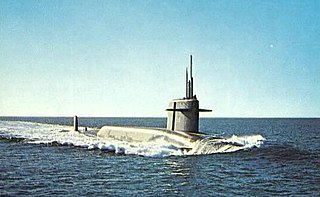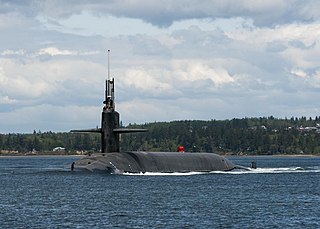
USS Patrick Henry (SSBN-599), named after the American Revolutionary War figure and Founding Father Patrick Henry (1736–1799), was a George Washington class nuclear-powered fleet ballistic missile submarine of the United States Navy. She was later converted into an attack submarine and redesignated SSN-599.

USS George Washington (SSBN-598) was the United States's first operational ballistic missile submarine. She was the lead ship of her class of nuclear ballistic missile submarines, was the third United States Navy ship of the name, in honor of Founding Father George Washington (1732–1799), the first president of the United States, and was the first of that name to be purpose-built as a warship.

The George Washington class was a class of nuclear-powered ballistic missile submarines deployed by the United States Navy. George Washington, along with the later Ethan Allen, Lafayette, James Madison, and Benjamin Franklin classes, comprised the "41 for Freedom" group of submarines that represented the Navy's main contribution to the nuclear deterrent force through the late 1980s.

USS Abraham Lincoln (SSBN-602), a George Washington-class fleet ballistic missile submarine, was the first ship of the United States Navy to be named for Abraham Lincoln (1809–1865), the 16th President of the United States (1861–1865).

USS Thomas A. Edison (SSBN-610), an Ethan Allen-class nuclear-powered ballistic missile submarine, was the second ship of the United States Navy to be named for the inventor, Thomas Edison (1847–1931).

USS Will Rogers (SSBN-659) was a Benjamin Franklin-class ballistic missile submarine – the last of the "41 for Freedom" Polaris submarines. She was the only ship of the United States Navy to be named for humorist Will Rogers (1879–1935).

USS Alexander Hamilton (SSBN-617) was a United States Lafayette-class ballistic missile submarine. It was the third ship of the United States Navy to be named for Founding Father Alexander Hamilton, the first US Secretary of the Treasury, who was instrumental in the formation of both the United States Coast Guard and the United States Navy.

USS Henry L. Stimson (SSBN-655), a Benjamin Franklin class fleet ballistic missile submarine, was the only ship of the United States Navy to be named for Henry L. Stimson (1867–1950), who served as U.S. Secretary of State (1929–1933) and U.S. Secretary of War.

USS Simon Bolivar (SSBN-641), a Benjamin Franklin class fleet ballistic missile submarine, was the only ship of the United States Navy to be named for Simón Bolívar (1783–1830), a hero of the independence movements of the former Spanish colonies in South America.

USS James K. Polk (SSBN-645), a Benjamin Franklin class fleet ballistic missile submarine, was the second ship of the United States Navy to be named for James K. Polk (1795–1849), the eleventh President of the United States (1845–1849). She was later converted into an attack submarine and redesignated SSN-645.

USS Alabama (SSBN-731) is the sixth Ohio-class nuclear-powered ballistic missile submarine, and the seventh United States vessel to be named for the state of Alabama. The boat's motto duplicates the state's motto, Audemus Jura Nostra Defendere.

USS John Adams (SSBN-620), a Lafayette-class ballistic missile submarine, was the second ship of the United States Navy to be named for Founding Father John Adams (1735–1826), the second President of the United States (1797–1801), and his son John Quincy Adams (1767–1848), the sixth President of the United States (1825–1829). Both names were used with the captains of the Blue and Gold crews alternately using the names John Adams and John Quincy Adams.

USS Woodrow Wilson (SSBN-624), a Lafayette class ballistic missile submarine, was the only ship of the United States Navy to be named for Woodrow Wilson (1856–1924), the 28th President of the United States (1913–1921). She later was converted into an attack submarine and redesignated SSN-624.

USS Henry Clay (SSBN-625), a Lafayette class ballistic missile submarine, was the only ship of the United States Navy to be named for Henry Clay (1777–1852), the American statesman and orator.

USS George Bancroft (SSBN-643), a Benjamin Franklin class fleet ballistic missile submarine, was the fourth ship of the United States Navy to be named in honor of George Bancroft (1800-1891), United States Secretary of the Navy (1845–1846) and the founder of the United States Naval Academy.

USS Tecumseh (SSBN-628), a James Madison-class ballistic missile submarine, was the fourth ship of the United States Navy to be named for Tecumseh (c.1768–1813), the leader of the Shawnee people.

USS Ulysses S. Grant (SSBN-631), a James Madison-class fleet ballistic missile submarine, was the third ship of the United States Navy to be named for Ulysses S. Grant (1822–1885), American Civil War general and the 18th President of the United States (1869-1877).

USS Casimir Pulaski (SSBN-633), a James Madison-class ballistic missile submarine, was the second ship of the United States Navy to be named for Casimir Pulaski (1745–1779), a Polish general who served in the American Revolutionary War.

USS Sam Rayburn (SSBN-635) was a James Madison-class fleet ballistic missile submarine named for Sam Rayburn (1882–1961), Speaker of the United States House of Representatives. Sam Rayburn was in commission 2 December 1964 to 31 July 1989 carrying the Polaris missile and later the Poseidon missile. Following decommissioning, ex-Sam Rayburn was converted into a moored training ship for use at the Naval Nuclear Prototype Training Unit at Goose Creek, South Carolina.

USS Stonewall Jackson, a James Madison-class fleet ballistic missile submarine, was the third ship of the United States Navy to be named for Confederate States Army General Thomas J. "Stonewall" Jackson (1824–1863).



















